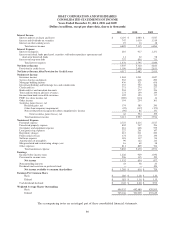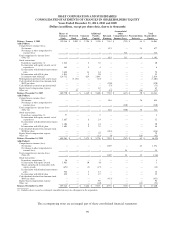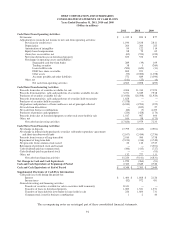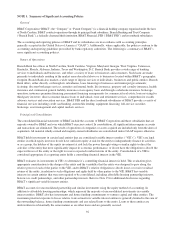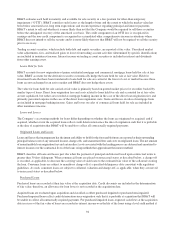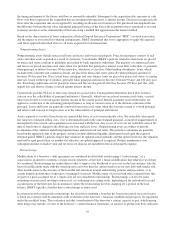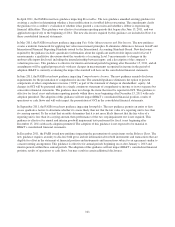BB&T 2011 Annual Report Download - page 95
Download and view the complete annual report
Please find page 95 of the 2011 BB&T annual report below. You can navigate through the pages in the report by either clicking on the pages listed below, or by using the keyword search tool below to find specific information within the annual report.the timing and amount of the future cash flows is reasonably estimable. Subsequent to the acquisition date, increases in cash
flows over those expected at the acquisition date are recognized prospectively as interest income. Decreases in expected cash
flows after the acquisition date are recognized by recording an allowance for loan losses. For purchased non-impaired loans,
the difference between the fair value and unpaid principal balance of the loan at the acquisition date is amortized or accreted
to interest income over the estimated life of the loans using a method that approximates the interest method.
Based on the characteristics of loans acquired in a Federal Deposit Insurance Corporation (“FDIC”) assisted transaction
and the impact of associated loss-sharing arrangements, BB&T determined that it was appropriate to apply the expected
cash flows approach described above to all loans acquired in such transactions.
Nonperforming Assets
Nonperforming assets include nonaccrual loans and leases and foreclosed property. Foreclosed property consists of real
estate and other assets acquired as a result of customers’ loan defaults. BB&T’s policies related to when loans are placed
on nonaccrual status conform to guidelines prescribed by bank regulatory authorities. The majority of commercial loans
and leases are placed on nonaccrual status when it is probable that principal or interest is not fully collectible, or generally
when principal or interest becomes 90 days past due, whichever occurs first. Other lending subsidiaries’ loans, which
includes both consumer and commercial loans, are placed on nonaccrual status generally when principal and interest
becomes 90 days past due. Direct retail loans, mortgage and sales finance loans are placed on nonaccrual status at varying
intervals, based on the type of product, generally when principal and interest becomes between 90 days and 180 days past
due. Revolving credit loans are not placed on nonaccrual but are charged off after they become 150 days past due, with
unpaid fees and finance charges reversed against interest income.
Certain loans past due 90 days or more may remain on accrual status if management determines that it does not have
concern over the collectibility of principal and interest. Generally, when loans are placed on nonaccrual status, accrued
interest receivable is reversed against interest income in the current period. Interest payments received thereafter are
applied as a reduction to the remaining principal balance as long as concern exists as to the ultimate collection of the
principal. Loans and leases are generally removed from nonaccrual status when they become current as to both principal
and interest and concern no longer exists as to the collectability of principal and interest.
Assets acquired as a result of foreclosure are carried at the lower of cost or net realizable value. Net realizable value equals
fair value less estimated selling costs. Cost is determined based on the sum of unpaid principal, accrued but unpaid interest if
not required to be reversed, and acquisition costs associated with the loan. Any excess of cost over net realizable value at the
time of foreclosure is charged to the allowance for loan and lease losses. Nonperforming assets are subject to periodic
revaluations of the collateral underlying impaired loans and foreclosed real estate. The periodic revaluations are generally
based on the appraised value of the property and may include additional liquidity adjustments based upon the expected
retention period. BB&T’s policies require that valuations be updated at least annually and that upon foreclosure, the valuation
must not be aged greater than six months old, otherwise an updated appraisal is required. Routine maintenance costs,
subsequent declines in market value and net losses on disposal are included in foreclosed property expense.
Restructurings
Modifications to a borrower’s debt agreement are considered troubled debt restructurings (“restructurings”) if a
concession is granted for economic or legal reasons related to a borrower’s financial difficulties that otherwise would not
be considered. Restructurings are undertaken in order to improve the likelihood of recovery on the loan and may take the
form of modifications made with the stated interest rate lower than the current market rate for new debt with similar risk,
other modifications to the structure of the loan that fall outside of normal underwriting policies and procedures, or in
certain limited circumstances forgiveness of principal or interest. Modifications of covered and other acquired loans that
are part of a pool accounted for as a single asset are not considered restructurings. Restructurings can involve loans
remaining on nonaccrual, moving to nonaccrual, or continuing on accruing status, depending on the individual facts and
circumstances of the borrower. In circumstances where the restructuring involves charging off a portion of the loan
balance, BB&T typically classifies these restructurings as nonaccrual.
In connection with commercial restructurings, the decision to maintain a loan that has been restructured on accrual status
is based on a current, well documented credit evaluation of the borrower’s financial condition and prospects for repayment
under the modified terms. This evaluation includes consideration of the borrower’s current capacity to pay, which among
other things may include a review of the borrower’s current financial statements, an analysis of global cash flow sufficient
95






